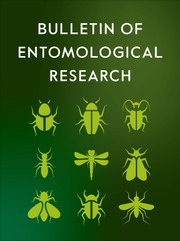Article contents
Geographical distribution and genetic analysis reveal recent global invasion of whitefly, Bemisia tabaci, primarily associated with only three haplotypes
Published online by Cambridge University Press: 17 February 2025
Abstract
The whitefly, Bemisia tabaci is a cryptic species complex in which one member, Middle East-Asia Minor 1 (MEAM1) has invaded globally. After invading large countries like Australia, China, and the USA, MEAM1 spread rapidly across each country. In contrast, our analysis of MEAM1 in India showed a very different pattern. Despite the detection of MEAM1 being contemporaneous with invasions in Australia, the USA, and China, MEAM1 has not spread widely and instead remains restricted to the southern regions. An assessment of Indian MEAM1 genetic diversity showed a level of diversity equivalent to that found in its presumed home range and significantly higher than that expected across the invaded range. The high level of diversity and restricted distribution raises the prospect that its home range extends into India. Similarly, while the levels of diversity in Australia and the USA conformed to that expected for the invaded range, China did not. It suggests that China may also be part of its home range. We also observed that diversity across the invaded range was primarily accounted for by a single haplotype, Hap1, which accounted for 79.8% of all records. It was only the invasion of Hap1 that enabled outbreaks to occur and MEAM1’s discovery.
Information
- Type
- Research Paper
- Information
- Copyright
- © The Author(s), 2025. Published by Cambridge University Press.
References
- 1
- Cited by


